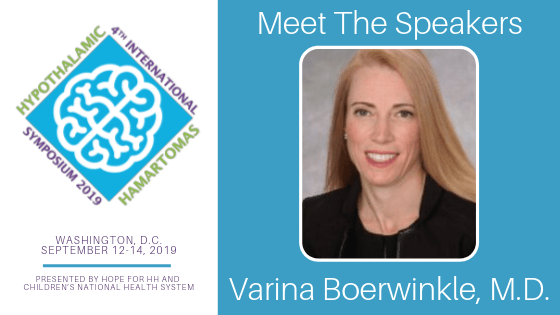
Hope for HH is co-sponsoring the 4th International Symposium on Hypothalamic Hamartomas – a professional symposium for HH investigators, clinicians and researchers – in Washington DC Sept. 12-14. The Symposium aims to identify gaps in understanding and opportunities for future HH research studies and collaborations to improve diagnosis, treatment and care of both the seizures as well as the other endocrinological and neuropsychological symptoms.
In this blog series, we will introduce you to several internationally recognized clinicians and researchers who are thought leaders both inside and outside of HH and who will serve as facilitators, presenters and discussants at the Symposium. Highlights of the Symposium will also be available to the HH patient and professional community following the meeting.
[/et_pb_text][et_pb_text _builder_version=”3.21.1″]
Meet Dr. Varina L. Boerwinkle
Varina Boerwinkle, MD is the medical director of the Neuro-Critical Care. Prior to joining Phoenix Children’s, Dr. Boerwinkle was the assistant professor of Pediatric Neurology at Baylor College of Medicine and a neurohospitalist for Texas Children’s Hospital.
Dr. Boerwinkle earned her bachelor’s degree in chemical Engineering from Texas A&M University and her medical degree from University of Texas Southwestern. She completed a residency from University of Texas Southwestern in obstetrics and gynecology and in pediatric and adult neurology from Baylor College of Medicine.
Dr. Boerwinkle is board certified in neurology with special qualifications in child neurology. She is a world leader in resting state-functional MRI for children, a tool she brings to Barrow at Phoenix Children’s for epilepsy surgery planning.
Dr. Boerwinkle is a member of numerous professional societies, including the American Academy of Pediatrics and Child Neurology Society.
Dr. Boerwinkle will be presenting an update on her research. She developed resting state functional MRI (rs-fMRI) into a tool called Searchlight. Searchlight shows where inside a hypothalamic hamartoma (HH) seizures are coming from. This allows precise targeting of the seizure generator, increasing seizure freedom by 45%. She has also shown the pathway of abnormal connectivity from the HH through the rest of the brain. This may allow a window into understanding, and potentially treating, the cognitive and psychological changes experienced in HH.
What is your specialty training and background?
I am a pediatric neurologist and a specialist in resting state functional MRI (RS) in pediatric epilepsy.
How did you become interested in HH research and care? What are your contributions to the HH field of research and care?
As I am the director of the functional MRI Lab and study every patient evaluated for intractable epilepsy, I have acquired the largest resting state functional MRI (RS) data set in HH. This has led to the advancement in understanding the RS has the capacity to detect the location within the HH of where seizures start. Knowing where the seizures start allowed surgeons to destroy the smallest area possible (less than a centimeter, often) to reduce seizures and often cure the epilepsy in HH. It also led to understanding what is the seizure network in HH.
The Symposium is important because
The meeting of the world’s experts on HH caregivers and families allows for the most open exchange of ideas and problems directly from those who are on the front lines to the scientists with the brightest ideas and skill sets to tackle these issues. It leads to advancements in understanding the most up to date thinking in this area, allowing for acceleration of advancements in evaluation and treatment.
Outside of work passions
I love to be outdoors – hiking, biking, camping, scuba diving, and traveling.
Call to Action
Like to share your feedback about the Symposium, speaker or topic, please send your comments to info@hopeforhh.org.
Would you like to support the Symposium and research with a donation to Hope for HH? Click here to Donate.





